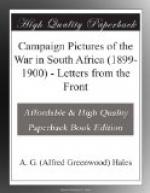At dawn on Wednesday we moved forward rapidly, and in a few hours’ time our infantry were standing in the trenches and upon the hills that the Boers had occupied the day before. Our mounted men rode at a gallop through the gullies, but nothing was to be seen of the foe except a few newly dug graves. The Boers had vanished like a dream, taking all their guns with them. Louis Botha, the commander-in-chief, had come in person to them, and the retreat was carried out under his eyes. We followed to Dewetsdorp, and from there on to Thaba Nchu (pronounced Tabancha).
On Friday night the enemy exchanged a few shots with us from the heights beyond, but no harm was done on either side. The Third Division, to which I had attached myself, under General Chermside, has been ordered towards Bloemfontein. French is in command, and, judging by his past performances, I fully expect we shall have some busy times, though French may go away and leave the Eighth Division under General Rundle.
With Rundle in the free state.
Orangefree state.
Since the Boers bolted from Constantia Farm we have done but little beyond following them from spot to spot through the Free State, in the conquered territory along the Basuto border. At Constantia Farm they gave us a gunnery duel, which, though incessant and continuous, did little real damage to either side. After that, when General French joined issue with us, the Boers shifted their ground with consummate skill. We moved on to Dewetsdorp, and there the Third Division, under Chermside, parted company with us. We moved onward to Thaba Nchu, Brabant keeping well away towards the Basuto border with his flying column. At Thaba Nchu it looked day by day as if we were in for something hot and hard, the Boers having, as usual, taken up a position of vast natural strength. But Hamilton was the only one to get to close quarters with the veldt warriors, when executing a flanking movement. I have since learned that the enemy suffered very severely on that occasion.
They can give some of the British journalists a wholesome lesson in regard to manliness of spirit, these same rough fellows, bred in the African wilds. Speaking to me of the charge the Gordons made, when led by Captain Towse, they were unstinted in their praises. “It was grand, it was terrible,” they said, “to see that little handful of men rush on fearless of death, fearless of everything.” It was bravery of the highest kind, and they admired it, as only brave men do admire courage in a foeman. The people of Britain who read extracts taken from Boer newspapers, extracts which ridicule British pluck and all things British, must not blame the Boers for those statements. In nearly every case the papers published inside Burgher territory are edited by renegade Britons, and it is these renegades, not the fighting Boers, who defame our nation, and take every possible opportunity of hitting below the belt.




